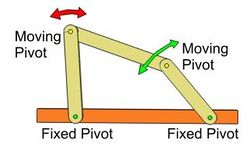Four Bar Chain: Difference between revisions
From DT Online
(Created 4 Bar Chain) |
(Added links) |
||
| Line 1: | Line 1: | ||
[[File:4BarChain.jpg |250px|right]] | [[File:4BarChain.jpg |250px|right]] | ||
A [http://en.wikipedia.org/wiki/Four-bar_linkage '''Four Bar Chain'''] is a linkage with four pivots, two of which are fixed - the bed or surface they are fixed to may be regarded as the fourth bar or link. | A [http://en.wikipedia.org/wiki/Four-bar_linkage '''Four Bar Chain'''] is a [[linkage]] with four pivots, two of which are fixed - the bed or surface they are fixed to may be regarded as the fourth bar or link. | ||
Varying the lengths of the links can cause the output to speed up or slow down and describe a different arc to the input. The lengths of links can be arranged such that a continuous '''rotary motion''' input can result in an output with '''oscillatory motion'''. | |||
Examples of the use of 4 Bar Chains can be found in vehicle [http://en.wikipedia.org/wiki/Double_wishbone_suspension suspension] and [https://en.wikipedia.org/wiki/Ackermann_steering_geometry steering] systems. | |||
Revision as of 20:35, 10 February 2015
A Four Bar Chain is a linkage with four pivots, two of which are fixed - the bed or surface they are fixed to may be regarded as the fourth bar or link.
Varying the lengths of the links can cause the output to speed up or slow down and describe a different arc to the input. The lengths of links can be arranged such that a continuous rotary motion input can result in an output with oscillatory motion.
Examples of the use of 4 Bar Chains can be found in vehicle suspension and steering systems. Template:Secondary Mechanisms Template:Primary Mechanisms
